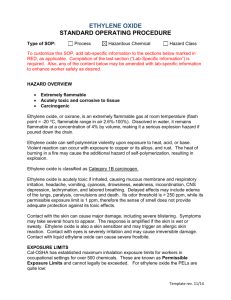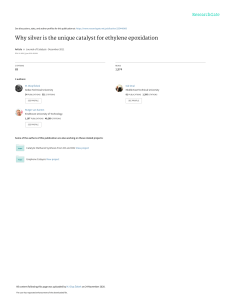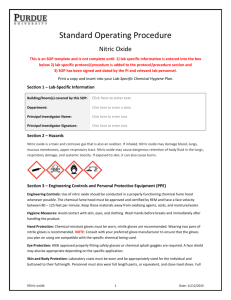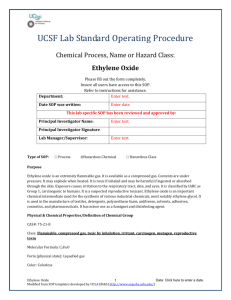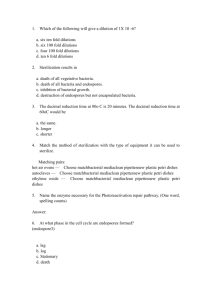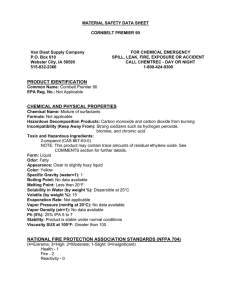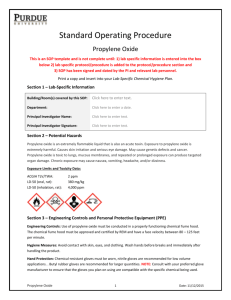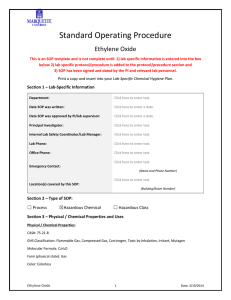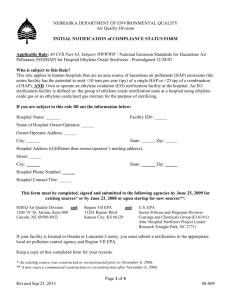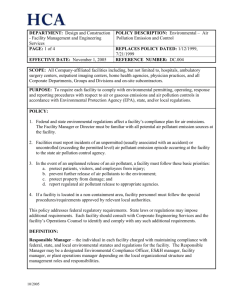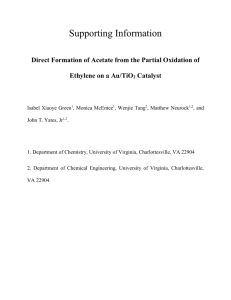Ethylene Oxide
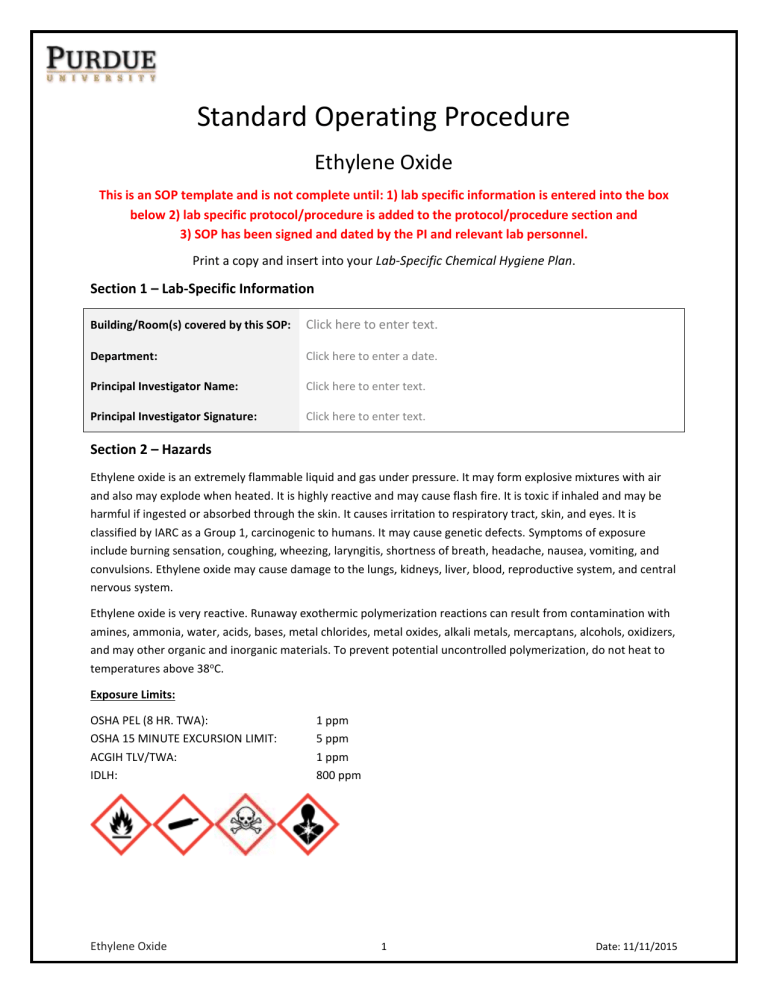
Standard Operating Procedure
Ethylene Oxide
This is an SOP template and is not complete until: 1) lab specific information is entered into the box below 2) lab specific protocol/procedure is added to the protocol/procedure section and
3) SOP has been signed and dated by the PI and relevant lab personnel.
Print a copy and insert into your Lab-Specific Chemical Hygiene Plan.
Section 1 – Lab-Specific Information
Building/Room(s) covered by this SOP: Click here to enter text.
Department: Click here to enter a date.
Principal Investigator Name:
Principal Investigator Signature:
Click here to enter text.
Click here to enter text.
Section 2 – Hazards
Ethylene oxide is an extremely flammable liquid and gas under pressure. It may form explosive mixtures with air and also may explode when heated. It is highly reactive and may cause flash fire. It is toxic if inhaled and may be harmful if ingested or absorbed through the skin. It causes irritation to respiratory tract, skin, and eyes. It is classified by IARC as a Group 1, carcinogenic to humans. It may cause genetic defects. Symptoms of exposure include burning sensation, coughing, wheezing, laryngitis, shortness of breath, headache, nausea, vomiting, and convulsions. Ethylene oxide may cause damage to the lungs, kidneys, liver, blood, reproductive system, and central nervous system.
Ethylene oxide is very reactive. Runaway exothermic polymerization reactions can result from contamination with amines, ammonia, water, acids, bases, metal chlorides, metal oxides, alkali metals, mercaptans, alcohols, oxidizers, and may other organic and inorganic materials. To prevent potential uncontrolled polymerization, do not heat to temperatures above 38 o C.
Exposure Limits:
OSHA PEL (8 HR. TWA):
OSHA 15 MINUTE EXCURSION LIMIT:
ACGIH TLV/TWA:
IDLH:
1 ppm
5 ppm
1 ppm
800 ppm
Ethylene Oxide 1 Date: 11/11/2015
Section 3 – Engineering Controls and Personal Protective Equipment (PPE)
Engineering Controls: Use of ethylene oxide must be conducted in a properly functioning chemical fume hood. The chemical fume hood must be approved and certified by REM and have a face velocity between 80 – 125 feet per minute.
Hygiene Measures: Avoid contact with skin, eyes, and clothing. Wash hands before breaks and immediately after handling the product.
Hand Protection: Chemical-resistant gloves must be worn, nitrile gloves are recommended. Wearing two pairs of nitrile gloves is recommended. NOTE: Consult with your preferred glove manufacturer to ensure that the gloves you plan on using are compatible with the specific chemical being used .
Eye Protection: ANSI approved properly fitting safety glasses or chemical splash goggles are required. A face shield may also be appropriate depending on the specific application.
Skin and Body Protection: Flame resistant laboratory coats must be worn and be appropriately sized for the individual and buttoned to their full length. Personnel must also wear full length pants, or equivalent, and closetoed shoes. Full length pants and close-toed shoes must be worn at all times by all individuals that are occupying the laboratory area. The area of skin between the shoe and ankle must not be exposed.
Respiratory Protection: Ethylene oxide should never be used outside of a chemical fume hood or glove box; therefore respiratory protection should not be required. Additionally, an air purifying respirator with an organic vapor cartridge is not sufficient to protect against ethylene oxide.
Section 4 – Special Handling and Storage Requirements
Always wear appropriate PPE when handling. Avoid contact with skin, eyes, and clothing. Avoid inhalation.
Use spark-proof tools and explosion-proof equipment.
Keep away from heat, sparks, flames, and other sources of ignition.
Prevent build-up of electrostatic charge.
Protect compressed gas cylinders from physical damage.
Conditions for safe storage:
Keep container tightly closed in a cool, dry, and well-ventilated area.
Contents under pressure.
Cylinders should be stored upright with valve protection cap and secured firmly to prevent falling.
Recommended storage temperature is 2 – 8 o C. Never store above 52 o C.
Protect from sunlight.
Section 5 – Spill and Accident Procedures
Immediately evacuate area and ensure others are aware of the spill. If there is an imminent threat of a fire, pull the nearest fire alarm station to evacuate the building and dial 911 . If personnel have become exposed and need medical assistance, dial 911 .
Section 6 – Waste Disposal Procedures
Store hazardous waste in closed containers that are properly labeled, and in a designated area (flammable cabinet is recommended) away from incompatible chemicals such as aqueous solutions. Complete a Chemical Waste
Ethylene Oxide 2 Date: 11/11/2015
Pickup Request Form to arrange for disposal by REM; detailed instructions are provided at the following link: http://www.purdue.edu/ehps/rem/hmm/chemwaste.htm
.
Section 7 – Protocol (Add lab specific Protocol here)
Click here to enter text.
NOTE: Any deviation from this SOP requires approval from Principal Investigator.
Section 8 – Documentation of Training
(signature of all users is required)
Prior to conducting any work with ethylene oxide , the Principal Investigator must ensure that all laboratory personnel receive training on the content of this SOP.
I have read and understand the content of this SOP:
Name Signature Date
Click here to enter text.
Click here to enter text.
Click here to enter a date.
Click here to enter a date.
Click here to enter text.
Click here to enter text.
Click here to enter a date.
Click here to enter a date.
Click here to enter text.
Click here to enter text.
Click here to enter a date.
Click here to enter a date.
Click here to enter text.
Click here to enter text.
Click here to enter a date.
Click here to enter a date.
Ethylene Oxide 3 Date: 11/11/2015
